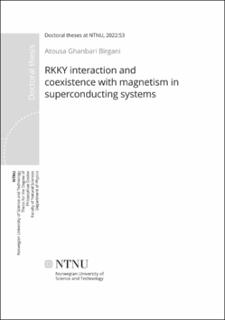| dc.contributor.advisor | Linder, Jacob | |
| dc.contributor.advisor | Sudbø, Asle | |
| dc.contributor.author | Birgani, Atousa Ghanbari | |
| dc.date.accessioned | 2022-03-02T07:35:26Z | |
| dc.date.available | 2022-03-02T07:35:26Z | |
| dc.date.issued | 2022 | |
| dc.identifier.isbn | 978-82-326-6330-9 | |
| dc.identifier.issn | 2703-8084 | |
| dc.identifier.uri | https://hdl.handle.net/11250/2982258 | |
| dc.description.abstract | When cooled down, the electrical resistivity of certain materials suddenly drops to zero at some specific temperature. This phenomenon is called superconductivity. As we are living in a world steadily demanding more energy, being able to prevent energy loss by transferring electrical currents through superconducting wires would be a huge advantage. Unfortunately, superconductivity normally sets in at quite low temperatures. Applications are therefore limited to cases where the benefit of superconductivity outweighs the cost of cooling down the material. Still, superconductors are, for example, used to make the strong magnetic fields that are needed in MRI devices, helping patients in hospitals.
Superconductors can also be useful for spin-based electronics where information is stored and transported using the electron spin, rather than the electron charge. Spin-based electronics seeks to make electronic devices smaller and faster, while wasting less energy than normal charge-based electronics. Combining superconductivity and spin-based electronics does, however, require combining superconductivity with magnetism. Although interesting phenomena can arise when superconductivity and magnetism meet, this can also be problematic as superconductors and magnets are natural enemies: Superconductors normally expel any magnetic fields applied to them and lose their superconducting properties when the applied field becomes too large.
This thesis provides an introduction to four research papers exploring interplay between superconductivity and magnetism. The magnetism is introduced through application of magnetic fields to superconductors or by placing superconductors next to magnetic materials. The articles investigate both interesting phenomena that can arise in such system, with possible applications within spin-based electronics, and how superconductors can be designed to withstand larger magnetic fields. | en_US |
| dc.language.iso | eng | en_US |
| dc.publisher | NTNU | en_US |
| dc.relation.ispartofseries | Doctoral theses at NTNU;2022:53 | |
| dc.relation.haspart | Paper 1:
Ghanbari Birgani, Atousa; Risinggård, Vetle Kjær; Linder, Jacob.
Self-consistent solution for the magnetic exchange interaction mediated by a superconductor. Scientific Reports 2021 ;Volum 11.
https://doi.org/10.1038/s41598-021-83620-3
This article is licensed under a Creative Commons Attribution 4.0 International License (CC BY 4.0) | |
| dc.relation.haspart | Paper 2:
Ghanbari Birgani, Atousa; Erlandsen, Eirik; Linder, Jacob.
Effect of midgap states on the magnetic exchange interaction mediated by a d-wave superconductor. Physical review B (PRB) 2021 ;Volum 104.(5)
https://doi.org/10.1103/PhysRevB.104.054502 | |
| dc.relation.haspart | Paper 3:
Ghanbari Birgani, Atousa; Linder, Jacob.
RKKY interaction in a spin-split superconductor. Physical review B (PRB) 2021 ;Volum 104.(9)
https://doi.org/10.1103/PhysRevB.104.094527
©2021 American Physical Society | |
| dc.relation.haspart | Paper 4:
Going beyond the Chandrasekhar-Clogston
limit in a at-band superconductor
arXiv:2109.13245 (2021) | |
| dc.title | RKKY interaction and coexistence with magnetism in superconducting systems | en_US |
| dc.type | Doctoral thesis | en_US |
| dc.subject.nsi | VDP::Mathematics and natural science: 400::Physics: 430 | en_US |
